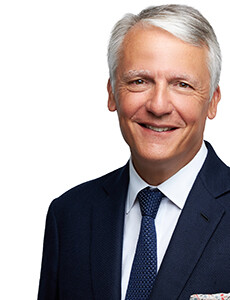A seasoned pair of insurance pros, Mitch Blaser and Mark Wheeler launched Mosaic Insurance in February. Here’s the story of their journey so far.
After representative careers that included long stints at Bermuda-based Ironshore, veteran commercial insurance executives Mark Wheeler and Mitch Blaser co-founded specialty insurer Mosaic Insurance in February of 2021.
This spring, Risk & Insurance editor-in-chief Dan Reynolds caught up with them to find out more about their motivations for founding Mosaic.
What follows is a transcript of that conversation, edited for clarity and length.
Risk & Insurance: Mark and Mitch, thanks for your time. We’re excited to get into the formation of Mosaic, but, briefly, you are both Ironshore veterans. We gather that’s where you met?
Mitch Blaser: We’re actually twin brothers … perhaps you can see the similarities!
It does go way back. We met at Ironshore when the company was looking to build a Lloyd’s international platform. And we were fortunate enough to have the opportunity to buy Pembroke [Managing Agency], and Mark and his team were there.
So, it goes back to 2008. And that’s how we met, through the acquisition process.
R&I: What about the Ironshore culture worked for both of you?
Mark Wheeler: I think the overarching theme of it was entrepreneurialism and empowerment. There was a prevailing sense in the firm that you could make a difference and achieve things. And there was encouragement to go and execute. It was a very nimble firm.
In that sense, it had many qualities we want to take forward into this business as well. We don’t see ourselves as a re-hash of Ironshore, though.
MB: Ironshore was a start-up, so you had to create everything and build from scratch effectively. One of the great things about Mark and I working together now is that we’ve come full circle. Back then, we would travel at least three time a year through Asia, as an example, talking to potential contingency capital and looking at where we were establishing new locations, setting up offices, meeting brokers, meeting clients.
That not only was an underpinning of the culture of Ironshore, but it also underscored how close we were in our thinking about how to build a company.
R&I: So now we come to Mosaic, both of you as co-founders and co-CEOs. What was your thinking in building this, and how did you bring this together?
MW: Mitch and I both spent much time thinking about the industry and how things could be done better. It’s a sad fact of life when you look up one day and say to yourself, “I’m one of those really boring insurance guys!” We’re always thinking about how things could be done better, both structurally and in terms of product. It’s a real continuum. I think Mosaic is truly starting from a blank slate, both structurally and via our products.
The first step was to evaluate different models. Where the frailties were, what could be done better. A big part of that engagement was also thinking about the technology enablement. Mitch talks about the fact we don’t have a tech legacy as being almost as important as not having a product legacy. It frees us up to lots of exciting initiatives.
But it wasn’t something where we went out to breakfast and said, “Wouldn’t it be great if we went to work together again?” Instead, it was a very natural evolution of thoughts and ideas over a long period of time.
MB: When you’ve spent as much time as we have in the industry, you get a sense of what works and what doesn’t. With a blank slate, we were able to pull together various components we thought could work together better and not get in the way of profitability — something that seems to happen a lot in the insurance business.
When people raise X billion dollars, especially to start a company, they raise those kinds of amounts to be relevant. But the problem is, you’ve got to deploy X billion dollars and you’ve got to make money on X billion dollars. On the flip side, if you’re a pure MGA, which we’re not, you have to find capital every time you want to write a piece of business.
So, we thought about the model a lot and had a lot of conversations along the lines of, “How do you integrate the best bits of both into one model?”
Those bits are what became Mosaic, and one of the reasons for the name ‘Mosaic’ is to take aspects of the industry, pull them together, and make a beautiful picture. I think that’s the underpinning, the structural aspect. It’s looking at how these components come together. It’s also about leveraging our combined multiple decades in the business.
Over time, you learn a lot, you meet a lot of people, relationships matter, and you pull it together.
R&I: What areas of focus and opportunities are you excited about, whether they be product lines or risks?
MB: Under Mosaic’s structure, the centerpiece is our Lloyd’s syndicate, for which we were able to secure the number ‘1609.’ It’s an obvious shout-out to Bermuda, although the reference is the date of the island’s English colonization after a shipwreck.
The syndicate allows us to provide the lead line as we set up and structure the underwriting. It also allows us to control the claim process. It also puts us in a position where we have more control over the levers of capital.
One of the most understated values of Lloyd’s is great gearing. We start with $1 of capital for $1 of premium, which drops to 85 cents; if you have to launch a Bermuda or U.S. balance sheet, you start at $1.25 and it never goes down.
“When you’ve spent as much time as we have in the industry, you get a sense of what works and what doesn’t. With a blank slate, we were able to pull together various components we thought could work together better and not get in the way of profitability — something that seems to happen a lot in the insurance business.” — Mitch Blaser, co-CEO, Mosaic Insurance
With other types of businesses, more standard lines, the capital model’s trickier. You may have raised a few billion dollars and you’re probably in the property CAT business instead of the specialty businesses we’re in.
Another major advantage to us is talent — being able to attract the right talent, technical skills, quality and experience, particularly for the lines of business we write. Then we complement those aspects with technology.
The technology in today’s world has changed so dramatically you can use it as a major advantage — to support your underwriting and create processing efficiencies. Technology can differentiate you on the frontend, providing artificial intelligence value to underwriters. So, we believe it’s an important feature not having legacy technology infrastructure.
R&I: Thanks, Mitch. Can you talk us through the product side, Mark?
MW: We started with a blank slate on products as well. This is a fast-moving era, where the underlying underwriting environment is changing, not to mention technology. We did a lot of research and thought very deeply about product.
Considering our model and the fact it’s a blend of proprietary and third-party capital, we felt one of the really important ingredients for us was the necessity to have an exceptionally high technical capability.
MGAs provide a great function on the distribution side. Where it all falls down, in our mind, is where you have a complex product and a complicated claim but not full claims-settling authority. So, that was an important overarching ingredient: this technical barrier.
The second priority was good, old-fashioned underwriting.
We wanted to put forward a book of business that we knew would outperform the market across cycles. This isn’t an inherited book that needs to be maintained; it’s a massive advantage just to be able to cherry-pick by line. And the threshold we set was that our combined ratio had to have at least an eight handle. That’s a big filter on most business and that’s the combined ratio across cycles, not just in this kind of market.
I think Golden Gate [Capital] are a phenomenal lead investor for us, particularly from the perspective of permanence of capital. We selected Golden Gate out of a number of possible investors because of its long-term commitment to this class.
Another important shareholder is Hannover Re. They were one of the anchor investors when Pembroke Managing Agency was set up. So, they’ve seen our underwriting through the complete cycle. They provided validation for us, they sat on our underwriting committee, they were actively engaged with our business. Hannover doesn’t take active positions in companies often.
An important, high-level filter for us was that we wanted business that would ordinarily exceed GDP — classes of business we knew would outperform market on profitability.
So, as we looked at utility, capital proficiency, trade markets — all the important things around underwriting governance — these fundamentals drew us towards a very narrow business, and we’re pleased about that.
Our challenge is going to be ensuring we stick to the integrity of this as we grow. We’re determined to do that. We want to be narrow, but very deep.
That’s another important feature in having Golden Gate as a backer: We can think out at least 10 years, probably longer. That gives us time to build, because we want to construct global top-tier franchises in our lines: transactional and tax liability, political risk, political violence, cyber, financial institutions and professional lines.
R&I: We appreciate the clarity on your advantages, they make a lot of sense. No legacy infrastructure tech-wise, no legacy book of business. And you mentioned you want to be narrow and deep. But in your position, what are your challenges?
MB: Getting our unique model up and running was the first challenge, including getting approval of our Lloyd’s Syndicate 1609. There had not been an independent syndicate approved by Lloyd’s since 2018, and that was pre-pandemic. We knew we had to navigate that. Luckily, working with Lloyd’s went well; it just took time.
Another key start-up challenge was making sure we had the right capital alignment. As Mark noted, Golden Gate Capital has been a fantastic partner. They use perpetual funds for their investments, giving them a long-term, strategic view, while allowing us to be very focused in the way we build our business, brick by brick.
Two other critical elements that we’re embracing now are talent and technology. We’ve been very fortunate on both.
On the talent side, we’ve been able to attract great leadership. Six of our seven planned businesses already have leaders on board, and we’ll be targeting other leading executives to join us down the road.
On the technology side, we have a great partnership with DXC to create an open platform bringing together all aspects of our technology. We’ve been working with them for several months, putting the platform in place, and we feel it will give us a tremendous advantage.
So, we’ve accomplished a lot to date and are forging ahead, tackling day-to-day challenges as we now expand.
MW: To Mitch’s point, we’ve got this new model and structure, and that’s exciting, but it needs to be explained and integrated.
We’re selling a London-syndicated product in lots of different places in the world — and that requires real positioning. Mitch and I led insurance businesses in 14 countries. From the get-go here at Mosaic, we’re opening in Bermuda, we’re opening in Hong Kong, we’re opening in London, we’re opening in New York, and probably opening in Toronto very shortly.
That’s a lot of geographic reach to get active right at the start, but it ties back to our value to third-party investors. We want to get that capital deployed where it’s needed rather than in a place that’s convenient for the industry. That’s the most important thing. At times of uncertainty, syndication really appeals to investors and insureds.
R&I: You mentioned having your business leaders in place. Can you point to some folks who you’re excited are on the team?
MW: This is a really important question for us, because Mosaic is not about star traders. We’re not about individuals; we’re not about violin virtuosos at all.
Mosaic is a symphony orchestra — we think we’ve got stars from percussion right through to first violin.
Importantly, at the cultural level, it’s not how we think about the business, it’s not how we act, it’s not how we engage, it’s not how we compensate.
However, because of the technical expertise we need, both marketplace and operationally, it’s true: We do have to attract leading talent. And we’re unashamedly going after high performers. These individuals all come together to make Mosaic the company it is.
R&I: And Mitch, since we’ve segued into that acquisition piece, in thinking about how you acquire and who you acquire, is there any more you want to add to what Mark gave us around how you look at talent, how you distinguish yourself given the well-known fact great talent can be tough to find?
MB: In our business, relationships matter. Whether you’re trying to do a deal, trying to track talent, trying to get something done.
Having had the longevity in the business, and a partner like Mark, I know strong relationships give you the firepower and connectivity to have those conversations.
Every conversation is an opportunity to talk about how exciting Mosaic is, the opportunity for value creation — the kind of opportunity that doesn’t come around too often.
R&I: Mark, is there anything you want to add to what Mitch just gave us there?
MW: Well, just reinforcing that it’s all about the culture. Just as with our products, we’re also carefully researching people.
You’ll see some companies go out and just recruit from name pools. We don’t do that; this is a hand-picked team.
Having said that, much of the senior talent coming on board has included people we hadn’t met previously. We set our net very widely, and one of the privileges of being a start-up is that we can take diversity really seriously.
We’ve borne that in mind right from the start of recruitment; we’ve got a blank slate that we can build any way we like. We’ve been looking for a blend of people with empathy, technical knowledge, intellect, commerciality. That’s a pretty rare package.
R&I: We’ve spoken about the advantage of not having a legacy infrastructure — what’s exciting about your use of technology and how it can drive the business?
MB: I like to think about technology in three pillars.
The first one really has to do with the way you can use technology to support underwriters and underwriting processes directly. It’s not just on the backend.
Today, with the kind of technology that exists, you can build AI-type frontends, which really are just taking algorithms and aligning them with each one of our businesses. So they actually help underwriters make their underwriting decisions.
If it’s an M&A business, the tech could be reading contracts. It could be looking for red flags, keywords, clauses that might indicate a problem or where the focus should be.
It creates productivity for underwriters, enabling them to be more efficient, more knowledgeable.
“Much of the senior talent coming on board has included people we hadn’t met previously. We set our net very widely, and one of the privileges of being a start-up is that we can take diversity really seriously.” — Mark Wheeler, co-CEO, Mosaic Insurance
Most importantly, the technology keeps getting smarter and that helps underwriters focus on what clients need as an end product.
The second aspect revolves around distribution, given our model’s various geographies and underwriting hubs around the world. Each one will be distributing capacity into a local market. As a result, we need a great way of staying connected, both internally and externally.
We’re leveraging blockchain to understand our exposures and aggregates, where we are at any time, not only for internal use but also so our third-party capital partners know where they are on any risk at any time. The platform provides real-time access to that data. If there’s a loss somewhere in the world, they’ll know if they’re on it.
The third pillar is straight-through processing.
Automated processing is something I’ve worked on before — we did it jointly at Ironshore. We got pretty far down the line, but the technology we had didn’t offer the opportunities we have today.
We see the ability to enter data as it comes in electronically and feed it through all the processes we have to go through in insurance, without having to re-enter data, as that’s typically where one loses productivity, inefficiency occurs and tremendous error rates occur.
Through our joint venture with DXC on an open platform, we have the benefit of leveraging modern technology that’s very modular. You can look at what’s available in the market, put it on your platform because it suits your needs, or modify or change it pretty easily.
As a result of that, we have the flexibility to address each of our businesses and their needs and create the expense-ratio advantage of straight-through processing.
R&I: Among the lines you are involved with, and among those risks, where do you potentially see clients needing the most help?
MW: We want to be client facing, we want to see as much business as possible and be preoccupied with that opportunity. We get good insights. We talk about a handful of critical topics every single time we speak to clients — we talk about extreme weather, cyber security and infectious diseases. Those are the three big headline concerns with clients at the moment.
Appropriately for us as a highly-focused specialty company, we’ve got to pick what goes on behind that. We’re not P&C, we don’t cover natural catastrophe-type perils. And that may be part of our appeal for some people.
Cyber is really obvious. If you thought that line of business was a good idea pre-COVID-19 or in the last 12 months, it’s clearly and obviously an area any specialty company should have a voice and a great product in now.
We need to think beyond the surface. COVID’s a great example: You have business interruption, you get event cancelation.
But what about all of the indirect exposures? What about economic instability? What about geopolitical-risk fallout? How is that accelerating what’s going on in the world?
These are all immensely relevant topics of our time, and every one of our lines of business is immersed in them. Everything from trade sanctions and governments behaving badly, our political risk book, through to weapons of mass destruction, our political violence book.
A great deal of the risk we find ourselves dealing with revolves around social unrest, which is at a level not seen before in our lifetime. It’s being driven by a great divergence of society at the moment, particularly that affecting refugees globally.
These are massive subjects that really speak to the purpose of Mosaic and our emphasis on international, cross-border exposures. In that sense, it’s rewarding to be involved in something that is helpful to risk management.
R&I: Given your structure and model and where you plan to be, how does regulation impact your business? Or, how do you look at either insurance regulation in the United States on the state-by-state basis or internationally?
MW: Indeed, one of our challenges is juggling the varying objectives of different regulators.
Many of your readers will understand what that means from a federal-versus-state engagement level, and then you multiply it across regions. It’s a challenge that gets amplified when you’re dealing with offices throughout the world, from North America to Southeast Asia.
MB: We are fortunate to have the Lloyd’s oversight, because its knowledge of our business, the credibility Lloyd’s brings to the processes it deploys to validate our business plan — it’s a tough but very valuable process.
It’s the gold standard for compliance and governance, so, “If you can do it there, you can do it anywhere” might be the theme of that.
But because of it, we carry that consciousness wherever we go and do business. It does give you a carrying card that’s powerful, having Lloyd’s oversight.
R&I: What factors or individuals impacted you as insurance executives?
MB: I was really fortunate in my years at Marsh to have met Bob Clements early in my career.
We worked together in the mid ’80s on forming Ace and XL, now Chubb and AXA XL. Those were both companies launched on the concept of market-making on the back of a world crisis at a certain point in time and responding to it based on client needs. Working with Bob as my mentor, I learned so much in terms of building companies and starting new businesses.
He also taught me that every problem is an opportunity. There’s a line I use all the time, which is, “If you don’t know where you’re going, any road will take you there.”
Understanding where you want to go and then envisioning how you get there is something I learned from Bob. I still give him credit for that way of thinking. And I try to deploy it in the real world.
MW: Mentoring is such a big part of our role in the company and how Mitch and I serve the people we work for. I think, for both of us, mentoring extends beyond work; it’s something that teaches you life lessons generally.
I’ve been fortunate; I’ve had two fantastic bosses in my career. The first was Rupert Villers, who, without a doubt, was the leading and most influential specialty writer at Lloyd’s in his generation.
Having learnt to underwrite literally sitting next to him on the box for 13 years, and eventually taking over the syndicate, was a phenomenal experience.
Another amazing mentor for me was Kevin Kelley — a great strategist and industry leader. Both Kevin and Rupert made us believe we were capable of doing things we didn’t think we were able to do.
Another important development for me in underwriting was being in the contact sport that is Lloyd’s. The lessons we learned. The trials and tribulations, particularly around complex risks; living in Lloyd’s through renewal and reconstruction; watching people’s character; learning truly about grit and determination and just never giving up. Learning to believe in yourself and just execute it.
R&I: Was there something either of you were thinking about, in talking about the founding of your company, your goals and aspirations, that we didn’t ask you, that you’d like to express?
MW: I think one of the most important things is how we’re positioned to take advantage of different types of capital coming into the market. One of the advantages we have, relative to established carriers, is we’ve got so much flexibility. The model allows us to engage with a broad range of capital, from pension funds to family offices.
MB: Our aspiration is to be top three in the lines we write in the next five, six, seven years. And with an aspiration in those lines, to be the best market for those particular requirements and needs of our clients.
That’s why focus is so important for us, and why we’re not in volatile businesses like property CAT and general liability, which require a lot of capital and at any given time can be wonderful or not wonderful because of that volatility.
Our lines of business should be consistently profitable, regardless of the rating market that we’re in.
That’s because of the way we underwrite it, the technical talent requirements, the technology support. All the ingredients we’ve put into this Mosaic formula that we expect to help us be profitable regardless of market cycle. And the use of capital: having control over capital levers is a powerful thing in our business; with a Lloyd’s capital base, we have a lot more flexibility in terms of when we want to ramp up or down. It’s easy to adjust accordingly.
MW: There’s one other thing we talk about the whole time — product development.
It’s something Ironshore was excellent at, and it’s a heritage we are absolutely determined to continue within Mosaic. It’s particularly relevant when you think about our lines. How we’re going to think about responding to exposure changes. The shift from physical to digital assets.
The risk landscape is evolving fast, and we need to be agile to meet that challenge. &
Dan Reynolds is editor-in-chief of Risk & Insurance. He can be reached at [email protected]
Originally found on Risk and Insurance Read More







